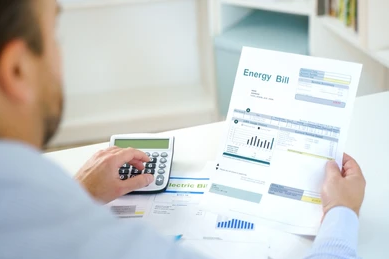Are you prepared for a shocking increase in electricity prices? Find out how it will impact your wallet!
By
- Replies 45
In our fast-paced modern lives, an undeniable reality looms over us — living expenses have a knack for stealthily mounting up, relentlessly consuming our hard-earned money.
We understand how crucial it is for SDC members to maximise their pension or superannuation and keep more of it in the bank.
And oh, how we wish we had better news for you on this fine day! But the cost of living, including those pesky energy bills, continues to escalate, with seniors among the hardest hit.
It has recently been revealed by the Australian Energy Regulator (AER) that energy prices are set to soar to staggering new heights, leaving millions of Australians potentially facing bigger bills.
What was once a whisper about a potential 20% to 22% rise has now been confirmed as a whopping increase between 21% and 24% come July.
You read that right, folks – 24%! This now leaves around 600,000 households across New South Wales, southeast Queensland, and South Australia staring down the barrel of yearly bill hikes of up to $512.

The Impact on Households
Your energy bills already seem like they burn a hole in your pocket, and this new pricing surge is set to burn through even more money.
Those in New South Wales can expect an increase of between $440 and $594 per year, depending on their location.
Residents in southeast Queensland have been forewarned about an extra outlay of around $402, while those residing in South Australia are looking at a hefty increase of $512.
The Burden on Small Businesses
It's not just households feeling the pinch; small businesses will also see the consequences of these rising energy prices, with increases between 14.7% to 28.9%.
The already fragile economy is sure to feel the burden as businesses struggle to keep their heads above water.
The Default Offer as a Safety Net
For those scratching their heads about the default offer, it serves as a backstop for around 9% of customers, preventing excessive charges on domestic users.
While many customers take advantage of lower, discounted rates, the default offer serves as a benchmark for wider prices.
The AER noted that stakeholder feedback was vital in shaping the final determination.
Reasons behind the Price Surge
The AER blames inflated wholesale energy costs on the rise in retail electricity prices. Clare Savage, Chair of the AER, underlined the care the agency took in considering the cost-of-living pressures faced by households and businesses. She recognised the need for retailers to recover their costs amidst these challenging times.
Savage also highlighted the importance of the default offer as a safety net for customers who haven't explored alternative power deals. She encouraged Aussies to shop around for the best options they could find.
'We know households and small businesses continue to face cost-of-living pressures on many fronts, and that's why it's important the (default offer) provides a safety net for those who might not have shopped around for a better power deal,' she remarked.
'No one wants to see rising prices, and we recognise this is a difficult time, that's why consumers need to shop around for a better deal.'
'The DMO is a protection against unjustifiably high prices, but our job is to make sure retailers can also recover their costs.'
Future Outlook
The May budget estimated a 10% increase in retail electricity prices for the 2023/24 period.
According to Ms Savage, this price increase is better than initially predicted in September.
She added that if the government had not intervened in the energy market, prices could have risen by a staggering 35% to 50%.
However, she noted that it is too early to determine whether prices have peaked and will eventually decrease.

So, while we brace ourselves for this upcoming increase, it's important to be proactive about reviewing our energy usage and the various deals available to us to make informed decisions and hopefully save some money in the long run.
Here are some tips to keep in mind when looking for a better electricity deal:
What are your tips for keeping electricity prices low? Let us know in the comments below – it just might save someone else from a financial shock in the future!
We understand how crucial it is for SDC members to maximise their pension or superannuation and keep more of it in the bank.
And oh, how we wish we had better news for you on this fine day! But the cost of living, including those pesky energy bills, continues to escalate, with seniors among the hardest hit.
It has recently been revealed by the Australian Energy Regulator (AER) that energy prices are set to soar to staggering new heights, leaving millions of Australians potentially facing bigger bills.
What was once a whisper about a potential 20% to 22% rise has now been confirmed as a whopping increase between 21% and 24% come July.
You read that right, folks – 24%! This now leaves around 600,000 households across New South Wales, southeast Queensland, and South Australia staring down the barrel of yearly bill hikes of up to $512.

Authorities announced price hikes on electricity bills, informing the general public of the additional charges they could be paying in the next few months. Credit: Shutterstock.
The Impact on Households
Your energy bills already seem like they burn a hole in your pocket, and this new pricing surge is set to burn through even more money.
Those in New South Wales can expect an increase of between $440 and $594 per year, depending on their location.
Residents in southeast Queensland have been forewarned about an extra outlay of around $402, while those residing in South Australia are looking at a hefty increase of $512.
The Burden on Small Businesses
It's not just households feeling the pinch; small businesses will also see the consequences of these rising energy prices, with increases between 14.7% to 28.9%.
The already fragile economy is sure to feel the burden as businesses struggle to keep their heads above water.
The Default Offer as a Safety Net
For those scratching their heads about the default offer, it serves as a backstop for around 9% of customers, preventing excessive charges on domestic users.
While many customers take advantage of lower, discounted rates, the default offer serves as a benchmark for wider prices.
The AER noted that stakeholder feedback was vital in shaping the final determination.
Reasons behind the Price Surge
The AER blames inflated wholesale energy costs on the rise in retail electricity prices. Clare Savage, Chair of the AER, underlined the care the agency took in considering the cost-of-living pressures faced by households and businesses. She recognised the need for retailers to recover their costs amidst these challenging times.
Savage also highlighted the importance of the default offer as a safety net for customers who haven't explored alternative power deals. She encouraged Aussies to shop around for the best options they could find.
'We know households and small businesses continue to face cost-of-living pressures on many fronts, and that's why it's important the (default offer) provides a safety net for those who might not have shopped around for a better power deal,' she remarked.
'No one wants to see rising prices, and we recognise this is a difficult time, that's why consumers need to shop around for a better deal.'
'The DMO is a protection against unjustifiably high prices, but our job is to make sure retailers can also recover their costs.'
Future Outlook
The May budget estimated a 10% increase in retail electricity prices for the 2023/24 period.
According to Ms Savage, this price increase is better than initially predicted in September.
She added that if the government had not intervened in the energy market, prices could have risen by a staggering 35% to 50%.
However, she noted that it is too early to determine whether prices have peaked and will eventually decrease.
Key Takeaways
- Energy prices are set to skyrocket by up to 24% for millions of Australians, with some households facing bill hikes of up to $512 a year.
- About 600,000 households in New South Wales, southeast Queensland, and South Australia will be affected by the changes.
- The Australian Energy Regulator (AER) said the rise in retail electricity prices was being driven by high wholesale energy costs.
- AER chair Clare Savage encouraged consumers to shop around for better deals and emphasised the importance of the default offer as a safety net for those facing cost-of-living pressures.
So, while we brace ourselves for this upcoming increase, it's important to be proactive about reviewing our energy usage and the various deals available to us to make informed decisions and hopefully save some money in the long run.
Here are some tips to keep in mind when looking for a better electricity deal:
- Make sure the retailer you select is reliable and offers good customer service. You can do this by reading online reviews or checking if they have any star ratings.
- Read the fine print and make sure you understand what the deal does and doesn’t include.
- Consider whether the plan is flexible enough for your needs.
- Make sure you ask about any discounts or incentives that might be on offer, such as bulk-buying discounts.
- Determine if the plan would benefit you in the long term.
What are your tips for keeping electricity prices low? Let us know in the comments below – it just might save someone else from a financial shock in the future!







